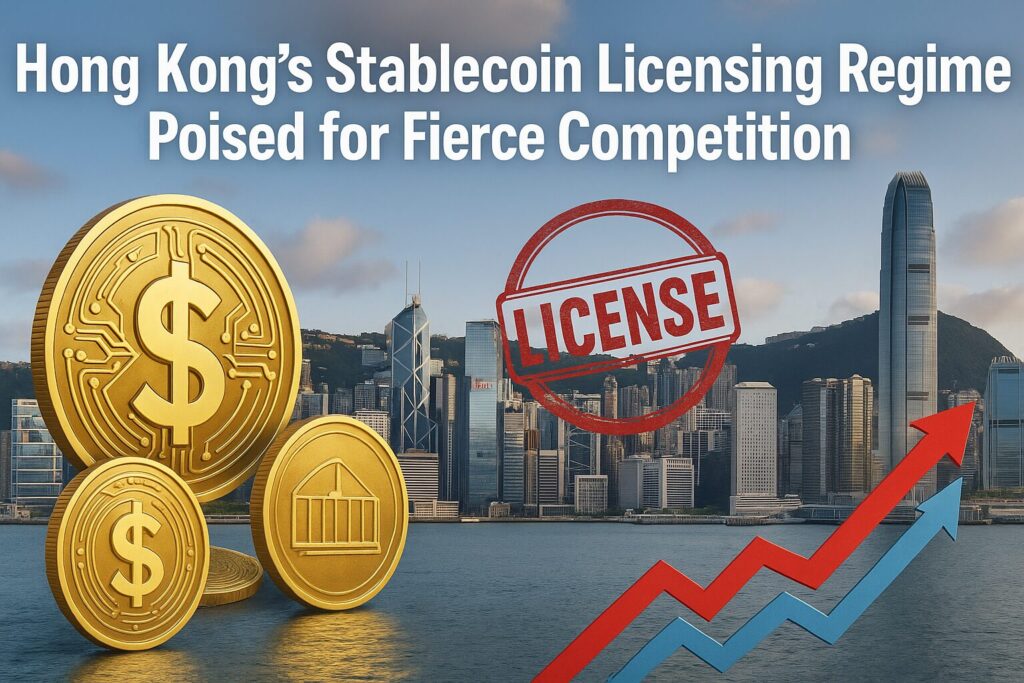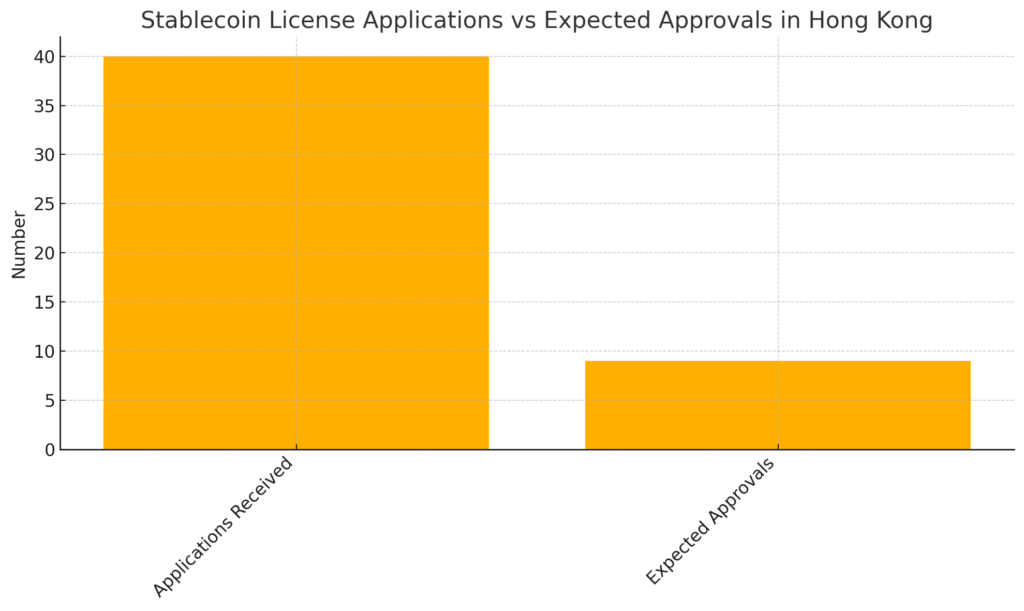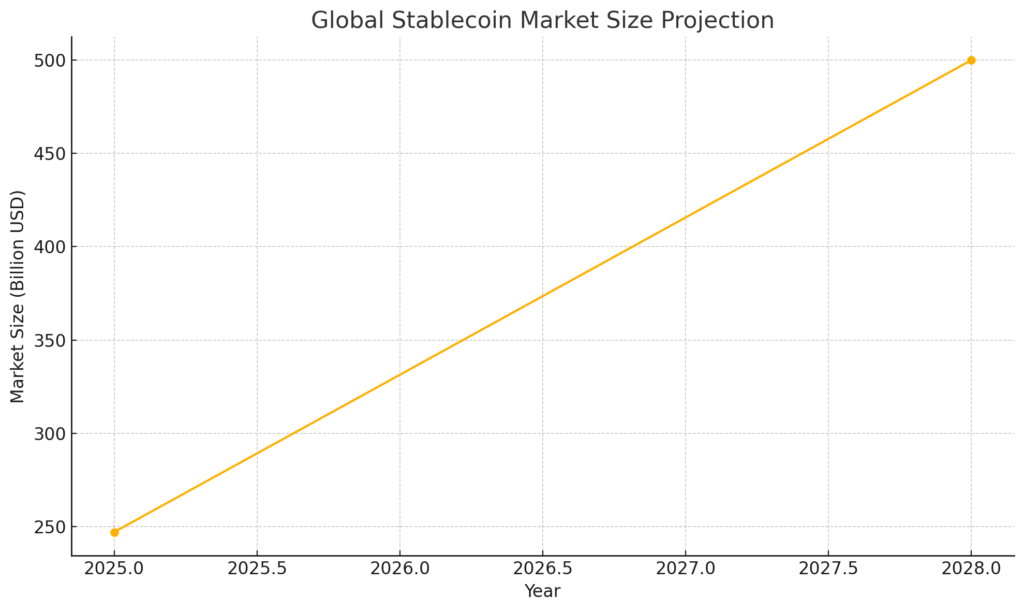
Main Points:
- Over 40 applications submitted for the August 1, 2025 stablecoin licensing launch in Hong Kong.
- Hong Kong Monetary Authority (HKMA) to approve only single-digit licenses, making the process exceptionally competitive.
- Sandbox phase saw just three participants—Standard Chartered/Animoca JV and JD.com, among others.
- Major Chinese banks, payment processors, and tech giants (JD.com, Ant Group) gearing up to apply.
- Regulatory framework passed May 21, 2025, with strict reserve, redemption, and risk‐control requirements.
- China’s tech firms lobbying for yuan‐pegged stablecoins to boost cross‐border payments and yuan internationalization.
- Global market still dominated by USD‐pegged stablecoins ($247 billion today, forecast to $500 billion by 2028).
- J.P. Morgan cuts long‐term stablecoin growth forecast to $500 billion, underscoring regulatory fragmentation.
- Implications for trade finance, remittances, DeFi integrations, and Hong Kong’s bid to be a digital‐asset hub.
1. Legislative Milestone and Regulatory Framework
In a landmark move to bolster its position as a global digital-asset center, Hong Kong’s Legislative Council passed the Stablecoins Ordinance on May 21, 2025. This legislation establishes a comprehensive licensing regime for fiat‐referenced stablecoin (FRS) issuers, requiring any entity issuing stablecoins in—or backed by—the Hong Kong dollar to obtain authorization from the HKMA.
Under the new framework, licensees must adhere to rigorous standards:
- Reserve Asset Management: Maintain high‐quality, liquid reserve assets at a 1:1 backing ratio.
- Redemption Procedures: Guarantee timely redemption at par value, with clear disclosures to holders.
- Risk Controls & Governance: Implement robust operational, cybersecurity, and AML/CFT controls.
Financial Secretary Christopher Hui emphasized “same activity, same risks, same regulation,” aligning stablecoin oversight with traditional finance to safeguard monetary and investor interests.
2. Sandbox Phase Highlights
Before the full regime launch on August 1, 2025, the HKMA ran a sandbox project to fine‐tune supervisory expectations and gather industry feedback. Participation did not guarantee eventual licensing; rather, it offered a trial environment for compliant stablecoin issuance models. Despite broad interest, only three entities—Standard Chartered/Animoca Brands JV, JD.com’s blockchain arm, and one other firm—were admitted, underscoring the narrow approval funnel.
3. Applicant Landscape: Who’s in the Race
Local media report that over 40 applications are already in preparatory stages for the August 1 rollout. Applicants span:
- Major Chinese Banks: Including Standard Chartered’s local JV.
- Payment Processors: Ant Group’s digital finance arm through Ant International.
- Tech Giants: JD.com and other internet conglomerates exploring USD‐ and yuan‐pegged stablecoin products.
However, HKMA signals that only single‐digit licenses will be granted, setting the stage for fierce competition and stringent evaluation of business models, compliance protocols, and systemic risk mitigation plans.
4. China’s Push for Yuan‐Pegged Stablecoins
Beyond Hong Kong dollar tokens, Chinese tech firms are lobbying the People’s Bank of China (PBOC) to authorize offshore renminbi-pegged stablecoins—starting in Hong Kong—to propel yuan internationalization and offer exporters a viable alternative to USD‐pegged coins like Tether.
- JD.com & Ant Group: Arguing that yuan‐pegged coins would enhance trade finance efficiency and reduce cross‐border payment frictions.
- Strategic Significance: Could serve as a testbed for eventual digital yuan layers in free trade zones, counterbalancing the 99% share of USD‐pegs in a market valued today at $247 billion.
5. Global Market Projections and Regulatory Realities
While Standard Chartered projects the stablecoin market to soar from $247 billion in mid-2025 to $2 trillion by 2028, J.P. Morgan has tempered expectations, forecasting a modest rise to $500 billion—citing fragmented regulation and limited real‐world payment use (just 6% of demand). These divergent forecasts reflect the uncertain intersection of DeFi innovation and compliance regimes worldwide.
6. Competitive Dynamics and Approval Odds
The HKMA’s cautious stance mirrors the SFC’s earlier approach: only 11 crypto‐exchange licenses have been granted since 2020, with high‐profile withdrawals over “inappropriate practices”. Applicants must differentiate via:
- Strong AML/CFT frameworks validated by third‐party audits.
- Advanced redemption and reserve mechanisms ensuring immediate on-chain convertibility.
- Interoperability plans with major wallets, DeFi platforms, and payment rails.
Chart 1: Applications vs. Expected Approvals
Below is a visualization comparing the 40+ applications received against the single-digit licenses the HKMA is likely to grant:

7. Use Cases and Strategic Implications
Approved stablecoin issuers stand to capitalize on:
- Trade Finance: Reduced settlement times and lower FX slippage.
- Remittances: Cost-effective cross-border transfers, particularly for Southeast Asia corridors.
- DeFi Integration: Collateral in lending/borrowing protocols, DEX liquidity pools.
- Institutional On-ramping: Regulated stablecoins offer gateway products for asset managers.
For Hong Kong, a successful licensing rollout could cement its reputation as a leading digital-asset hub, attracting capital and talent from competitors like Singapore and Dubai.
Chart 2: Global Stablecoin Market Size Projection
Projected growth from $247 billion today to $500 billion by 2028 illustrates the market opportunity for licensed issuers:

8. Conclusion
Hong Kong’s stablecoin licensing regime, effective August 1, 2025, represents a turning point in regulated digital finance. With over 40 contenders vying for single-digit slots, the HKMA’s stringent framework will reward only those with robust risk management, clear redemption processes, and compelling use cases. As Chinese banks and fintech giants push for both HKD- and RMB-pegged tokens, and as global projections range widely from $500 billion to $2 trillion, the winners of this licensing round will shape the next wave of blockchain-driven financial innovation.

